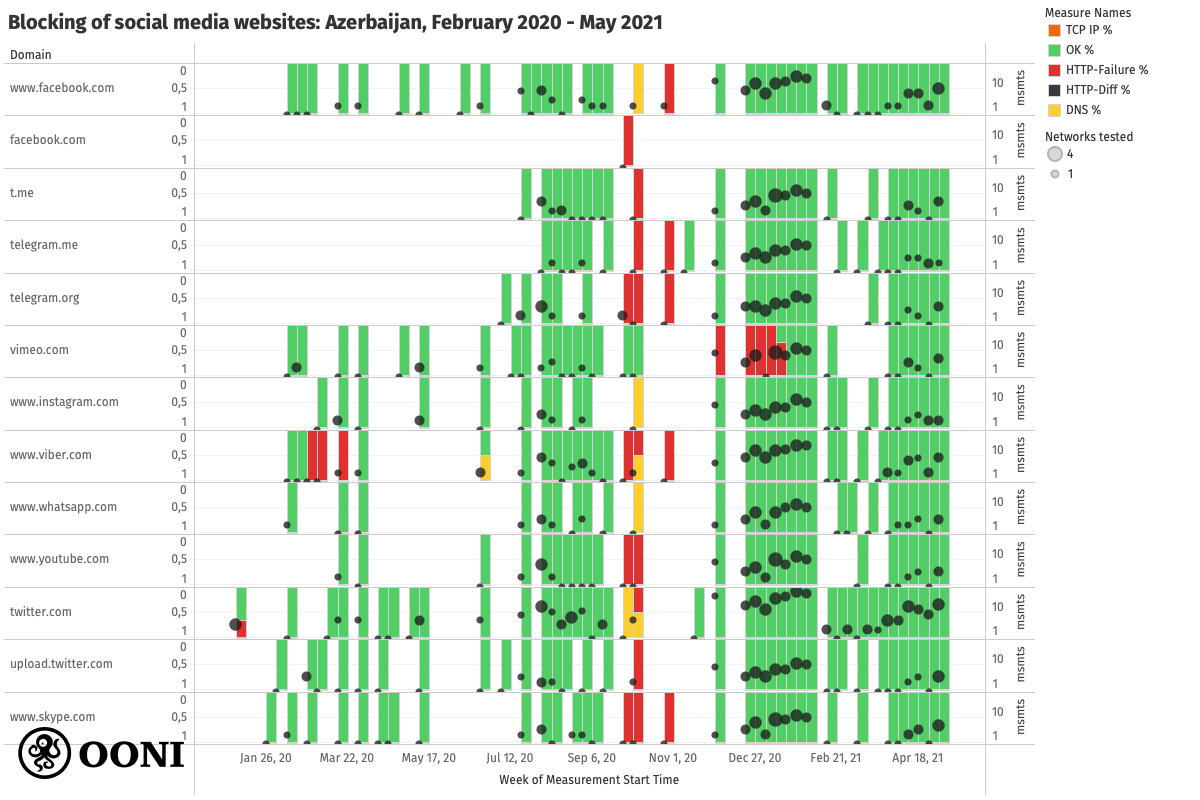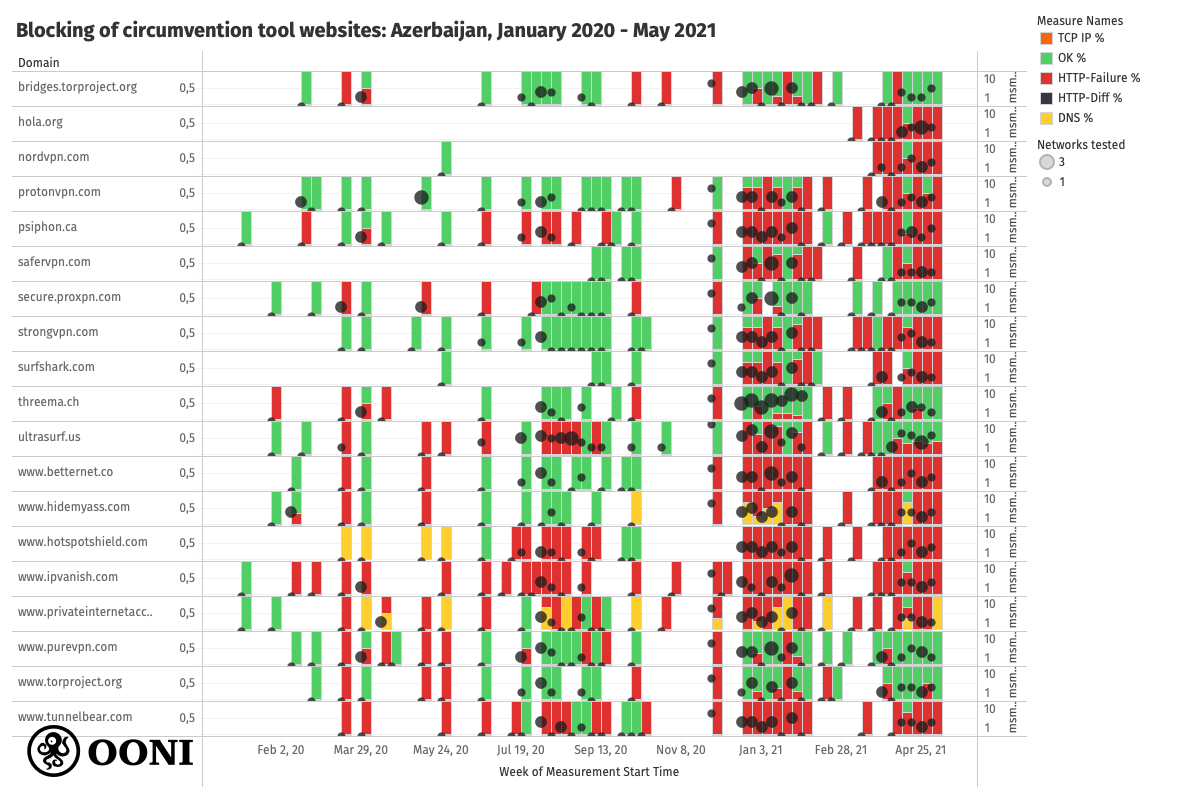On July 1, Azerbaijan Internet Watch launched a new report titled “Media censorship in Azerbaijan through the lens of network measurement”. The report was prepared in partnership with the Open Observatory of Network Interference (OONI) summarising key findings from network measurements conducted between January 2020 to May 2021. The full report can be accessed here.
About the report
In light of reports on the blocking of websites in Azerbaijan, the Open Observatory of Network Interference (OONI) and Azerbaijan Internet Watch (AIW) formed a partnership to collaborate on researching internet censorship in the country. Over the past year, OONI and AIW have collaborated on collecting and regularly analyzing censorship measurements from Azerbaijan, while providing timely updates through reports. In this report, we share findings from our analysis of OONI network measurements collected from Azerbaijan between 1st January 2020 to 1st May 2021. The aim of this study is to document and increase the transparency of internet censorship in Azerbaijan through the analysis of empirical network measurement data.
Key findings
- Blocking of independent news media and circumvention tool websites. Throughout the testing period, several independent news media and circumvention tool sites presented HTTP failures caused by connection timeouts. This suggests the potential use of Deep Packet Inspection (DPI) by ISPs in Azerbaijan.
- Attempts to block Tor and Psiphon. ISPs in Azerbaijan attempted to block Tor and Psiphon amid the 2020 Nagorno-Karabakh war. However, both attempts appear to have been quite ineffective.
- Temporary blocking of social media amid 2020 Nagorno-Karabakh war. Between September 2020 to November 2020, several social media websites presented the same HTTP failures (as news media and circumvention tool sites), while the testing of WhatsApp and Telegram presented signs of TLS level interference.
- Variance of censorship across networks. ISPs in Azerbaijan appear to be adopting similar censorship techniques. However, censorship varies from network to network, as different ISPs block different websites and apps at different moments in time.
Blocked news media websites
Several independent news media websites presented signs of blocking in Azerbaijan throughout the analysis period.
These domains include:
- `azerbaycansaati.tv`
- `criminal.az`
- `www.24saat.org`
- `www.abzas.net`
- `www.azadliq.info`
- `www.azadliq.org`
- `www.gununsesi.info`
- `www.gununsesi.org`
- `www.kanal13.tv`
- `www.meydan.tv`
OONI data also suggests that the site (`www.occrp.org`) of the Organized Crime and Corruption Reporting Project (OCCRP) and the site (`www.rferl.org`) of RadioFreeEurope/RadioLiberty (RFE/RFL) were blocked in Azerbaijan as well. The blocking of the OCCRP site reportedly began in September 2017, following the publication of a major investigation (“Azerbaijani Laundromat”) into corruption, bribery, and money laundering in which powerful figures were allegedly involved. The blocking of the RFE/RFL website also reportedly began in 2017, following an Azerbaijani court order which RFE/RFL described as “another blatant attempt at silencing its reporting in the country”.
Blocking of social media amid 2020 Nagorno-Karabakh war
Amid the 2020 Nagorno-Karabakh war, OONI data shows that access to several social media websites and apps was blocked in Azerbaijan. The following chart, limited to social media websites that presented signs of blocking between February 2020 to May 2021, aggregates OONI measurement findings collected from 4 AS networks in Azerbaijan.

As is evident from the above chart, most of these social media websites primarily presented signs of blocking during the 2020 Nagorno-Karabakh war (between 27th September 2020 to 10th November 2020), but were found accessible when tested (on several networks in Azerbaijan) in the months before and after the war. Notably, most anomalous measurements presented HTTP failures (because the HTTP requests timed out), similarly to the blocking of news media websites (discussed previously). This provides a stronger indication that these social media websites were blocked, particularly since ISPs often use the same censorship technique(s) to block a variety of different websites.
Blocked circumvention tool sites
Numerous circumvention tool websites presented signs of potential blocking when tested (on up to 3 AS networks) in Azerbaijan between February 2020 to May 2021, as illustrated through the following chart.

Similar to the blocking of news media and social media websites, we observe that the testing of circumvention tool websites often resulted in HTTP failures caused by connection timeouts. This consistency in terms of failures, observed on several AS networks over the period of a year, strongly suggests blocking of these circumvention tool websites. As testing coverage increased from January 2021 onwards, we observed an increased volume of anomalous measurements, most presenting the same HTTP failures.
Conclusion
Press freedom appears to be quite limited in Azerbaijan, as suggested by the blocking of several independent news media websites in the country. These media websites presented signs of blocking throughout their testing (on several local AS networks) between January 2020 to May 2021 (corroborating past reports on the blocking of media websites in Azerbaijan), with recent OONI measurements suggesting that their blocking remains ongoing.
Potentially in an attempt to prevent the circumvention of media censorship, ISPs in Azerbaijan appear to have blocked access to a number of circumvention tool websites over the last year as well. It remains unclear, however, if the apps of these circumvention tool sites were also blocked (as they were not tested as part of this study); and even if they were, it’s possible that local internet users may have been able to use them nonetheless, given that circumvention tools often include in-built circumvention techniques for evading censors.
Amid the 2020 Nagorno-Karabakh war, ISPs in Azerbaijan appear to have attempted to block the Tor and Psiphon circumvention tools. Yet, these attempts were likely ineffective, given that both tools have in-built circumvention techniques and fallback options for circumventing blocks. In Tor measurements, we observe that most ISPs did not block all tested Tor directory authorities, suggesting that it was possible to use Tor nonetheless (as also indicated by the spike in Tor usage from Azerbaijan during that period). Similarly, many Psiphon measurements during this period were successful, suggesting that it may have been possible to use the Psiphon VPN on many networks.
Several social media websites (such as `www.facebook.com` and `www.youtube.com`) and apps (primarily WhatsApp and Telegram) presented signs of blocking between September 2020 to November 2020, which coincides with the 2020 Nagorno-Karabakh war. It is, therefore, possible that ISPs may have increased efforts to block circumvention tools (during this period) in an attempt to prevent the circumvention of social media censorship.
Interestingly, we observe similar censorship techniques adopted by different ISPs in Azerbaijan, but variance in terms of which internet services are blocked by ISPs over time. In other words, we see ISPs blocking websites and apps in similar ways (seemingly using the same censorship techniques), but different ISPs block access to different websites and apps (and sometimes this varies at different moments in time).
Throughout the testing period, independent news media and circumvention tool websites presented HTTP failures caused by connection timeouts, suggesting the potential use of Deep Packet Inspection (DPI) by ISPs in Azerbaijan. Similarly, when social media websites were temporarily blocked amid the 2020 Nagorno-Karabakh war, their testing also presented HTTP failures caused by connection timeouts. This suggests that most ISPs in Azerbaijan block websites using similar (if not the same) censorship techniques.
Both WhatsApp and Telegram presented signs of TLS level interference on several different AS networks in Azerbaijan amid the 2020 Nagorno-Karabakh war. In the case of WhatsApp, the HTTP requests to `web.whatsapp.com` succeeded, while the HTTPS requests failed (during the TLS handshake), which could be an indication of SNI-based filtering. In the case of Telegram, we see that both HTTP and HTTPS requests to `web.telegram.org` timed out.
As media censorship (and the blocking of circumvention tool websites) appears to be ongoing in Azerbaijan, there is a need for further testing to evaluate these censorship events in more depth over time. The temporary blocking of social media amid the 2020 Nagorno-Karabakh war also suggests that new censorship events can emerge in Azerbaijan, as political events evolve.
This study was carried out through the use of open methodologies, free and open source software, and open data, enabling independent third-party verification of our research findings. We encourage researchers to expand upon this study by running OONI Probe and analyzing OONI measurements from Azerbaijan.